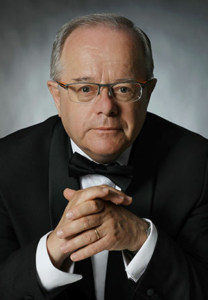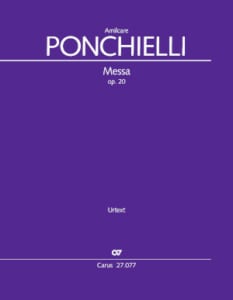Amilcare Ponchielli: Mass – an opera in church
The Messa is undoubtedly a masterpiece of 19th century Italian sacred music. And that is why it deserves to feature again in today’s concert repertoire, according to Marius Popp, Deanery Music Director in Kronach and founder and conductor of the South German Doctors’ Choir and Orchestra. He has conducted the Mass firstly in Cremona, then several times in Germany to highly enthusiastic audiences.
Amilcare Ponchielli (1834-1886) is known to audiences primarily as an opera composer; his most famous opera La gioconda (1876) is still in the operatic repertoire today.
On the 180th anniversary of Ponchielli’s birth in 2014 I accepted an invitation from Pietro Zappalà (the editor of the Mass) to give concerts in Italy with the South German Doctors’ Choir and Doctors’ Orchestra. We performed in Cremona Cathedral (Ponchielli was music director at the theater there for many years), in the Basilica Santa Maria Maggiore in Bergamo (where the first performance of the work was given), and in Bologna. Further performances followed in Germany in 2016.
The Mass was extremely well received both by musicians and audiences. We were delighted to be able to perform such an operatic work in church. Thus the Messa became a very special musical experience for all involved. It is undoubtedly a masterpiece of 19th century Italian sacred music. And that is why it deserves to be included in today’s concert repertoire once again.
Ponchielli’s church music works are very little known. At the peak of his career he took up the position of maestro di cappella at the Basilica of Santa Maria Maggiore in Bergamo. He composed the Mass like a new opera with which you would make your debut on the operatic stage. With this work, he wanted to prove his reputation as a composer once more, and at the same time to fulfil the city’s expectations.
The first performance was planned for Christmas 1882. The work is scored for three soloists (tenor, baritone, and bass), five-part choir and large orchestra, and sets the usual five sections of the mass ordinary (Kyrie, Gloria, Credo, Sanctus–Benedictus, and Agnus Dei). The first three of the sections are fairly extensive, and the last two shorter.
Pietro Zappalà, the musicologist and editor of this work, writes in his foreword: “The first performance of the Mass was a magnificent success, as can be seen from articles published both in the local press and in the leading music periodicals of the day (such as Gazzetta Musicale di Milano). The enthusiastic opinions of contemporaries essentially emphasize the following features in Ponchielli’s sacred music: a consistent interest in wide-ranging melodic arches, typical of the composer; the profound compositional technique shown in the rich harmonies and varied, colorful orchestration; the consummate balance of different compositional means and expressive levels in which all the elements blend to form a unity: the soloists’ unfolding melodies, the counterpoint in the fugues, the dense and varied presence of the choir and the carefully worked out orchestral writing.”
Marius Popp is Deanery Music Director at the Protestant Stadtkirche in Kronach. He is founder and director of the South German Doctors’ Choir and Orchestra.






Leave a Reply
Want to join the discussion?Feel free to contribute!